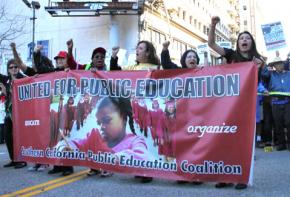What’s ahead after March 4?
, a student activist at the University of California Berkeley, gives a preview of the issues facing a group of anti-cuts activists when it meets in LA this weekend.
THE GRASSROOTS movement of students and workers against the devastating cuts to public education in California has reached a critical juncture. The protests for the March 4 Day of Action were huge, a spectacular display of popular anger at the outrageous attack on all levels of public education. Tens of thousands of people, in hundreds of schools and colleges around the state, participated in some form of grassroots action, giving us a glimmer of what our strength could look like if we plan and act in unison.
But now, as the end of the school year rapidly approaches, we are faced with some serious challenges, in particular, the question of the organization and deepening of our movement. The upcoming statewide gathering in Los Angeles can be an important step in the direction of addressing this challenge.
It is important that we recognize what this conference is and what it is not. Given that the movement is still in its infancy, and especially given that the conference was called and is being planned on extremely short notice, it is likely that it will be small.

We must recognize the fact that it will not be in any sense a representative gathering, nor should we expect it to be able to speak for the movement as a whole. Many active schools and colleges will not be present, and hence the minority who are able to make it to LA at short notice will have a disproportionate influence. As such, the suggestion that a steering committee with broad leadership powers could emerge from the LA meeting should be firmly opposed.
What the meeting can do, however, is act as a foundation from which to begin building for a genuinely representative, delegated conference in the fall, one which will bring together hundreds, maybe up to a thousand, of the most committed activists from around the state to concretize unifying political demands and an action plan capable of advancing the movement toward victory. A good date and venue for such a conference would be San Francisco State University on October 1-2.
Such a conference will require months of proper planning and statewide, coordinated efforts, which is why we should begin working on it now. A good Web site, a well-written call, material support from major unions and other bodies to help us figure out the logistics of transporting, housing and feeding hundreds of activists from across California--all this requires time and effort, and all of it is essential to making this conference a success. The LA gathering should make it a central priority to set up an ad-hoc coordinating body that can start working on doing mass outreach and planning the fall conference immediately.
THE RAPID growth of this movement, from its beginnings at UC Berkeley last September through March 4th, which saw actions not just in California, but nationwide and even internationally, has been exciting and inspiring. It is a sign of just how devastating these budget cuts have been and will continue to be, and of the widespread anger and determination to fight back. Big questions are being raised by students, teachers, workers and parents, and we need a movement that can take them up, and provide answers and a vision of the way forward.
A huge, representative conference in the fall is the launching pad we need to propel the struggle into its next phase and take on the politicians and administrators who are desperate to balance the budget on our backs. In the meanwhile, activists on campuses and in school districts across the state have plenty of local organizing ahead of us to continue bringing together activists at the grassroots.
The challenges ahead of us are myriad and our forces are still underdeveloped and relatively weak, but a well-organized, grassroots-led mass movement can overcome them all and beat back the powerful forces ranged against us.


